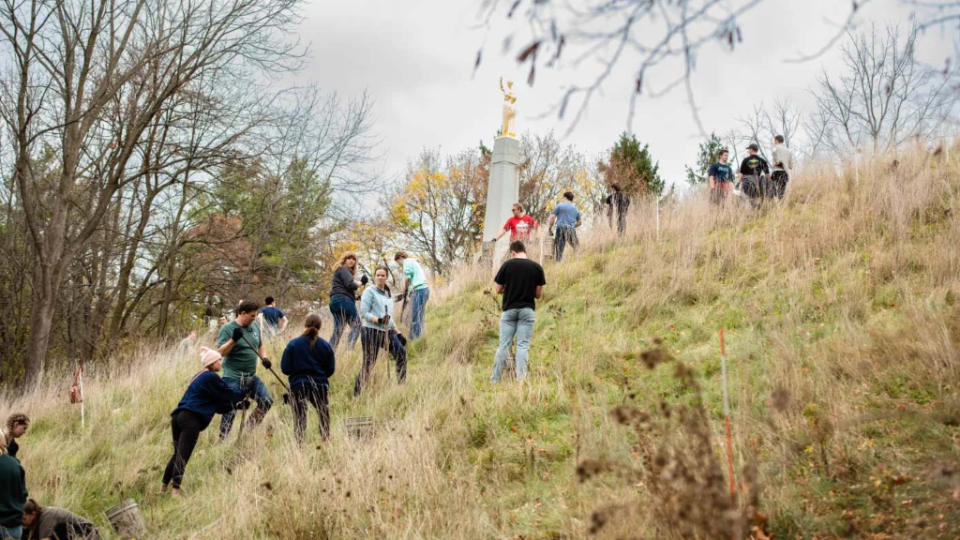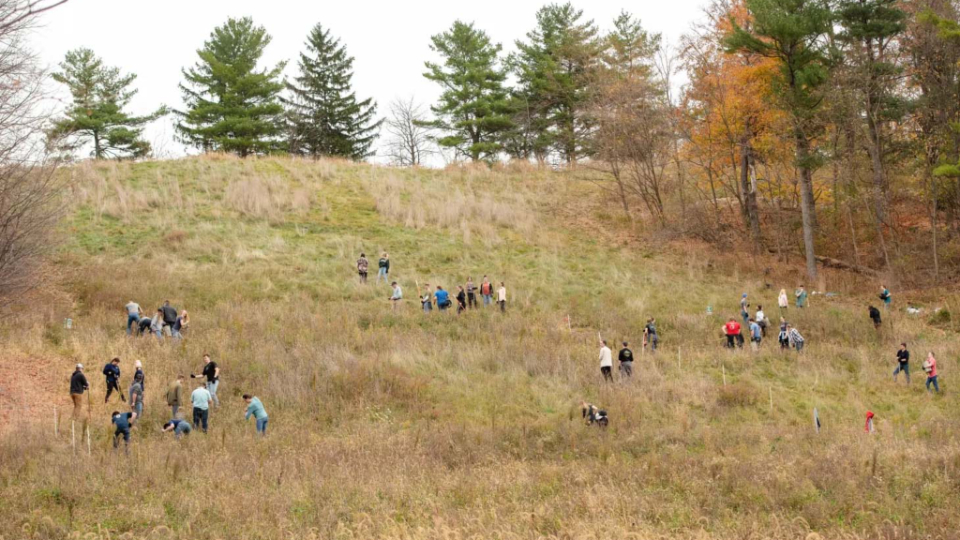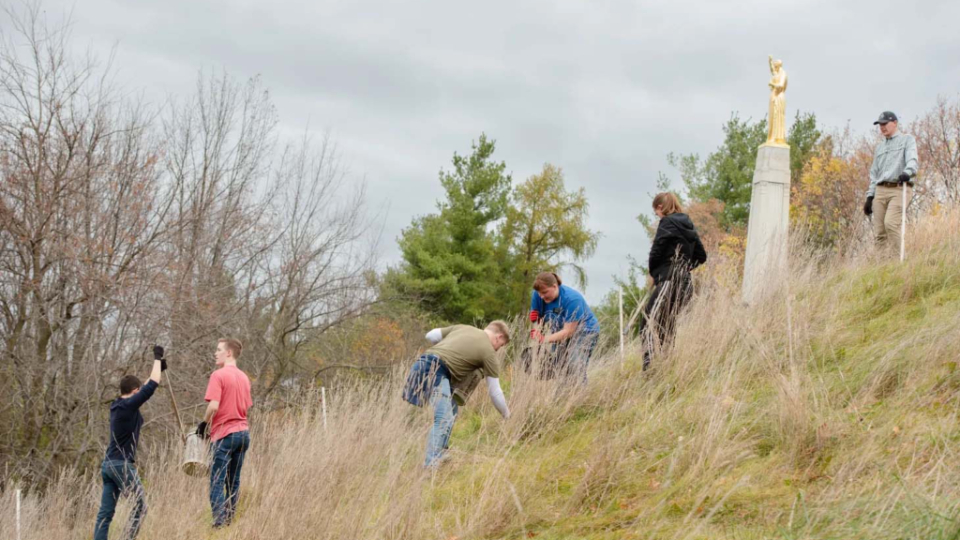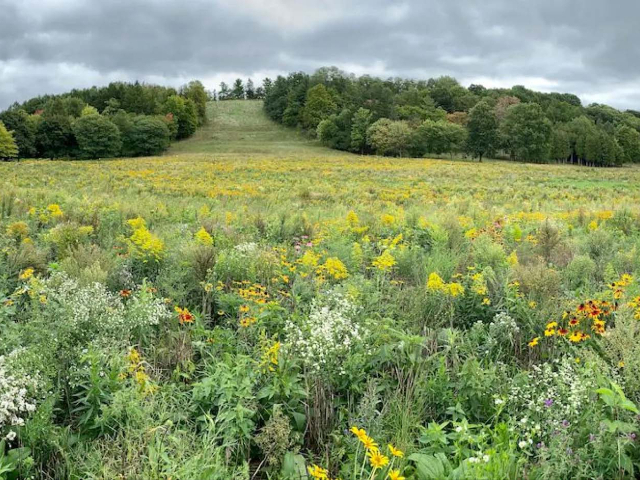
Hill-Cumorah-seeds-1
Missionaries of The Church of Jesus Christ of Latter-day Saints plant trees on the Hill Cumorah, a small hill and Church history site in Manchester, New York, on Friday, November 11, 2022. The missionaries planted the trees as part of a reforestation project by the Church. Photo courtesy of Lisa Christensen, courtesy of Church News.All rights reserved.
This story appears here courtesy of TheChurchNews.com. It is not for use by other media.
By Trent Toone, Church News
One day in 1928, a group of Latter-day Saint missionaries assembled at the base of the Hill Cumorah in upstate New York.
Willard Bean, a fellow missionary and caretaker of the nearby Joseph Smith family farm, stood halfway up the hill’s slope. The Church of Jesus Christ of Latter-day Saints had acquired the Hill Cumorah property, and Elder Bean recruited the missionaries to help plant tens of thousands of trees.
“Today we are sowers, not reapers,” Elder Bean said, according to Rand H. Packer’s book, “A Lion and a Lamb.” “You will see no baptism today from the sowing you will do. ... But some day, someone will reap a harvest from the seeds you plant today. Not just someone, but many. You write it down and remember it, for it will surely come to pass.”

Hill-Cumorah-seeds-2
Missionaries of The Church of Jesus Christ of Latter-day Saints plant trees on the Hill Cumorah, a small hill and Church history site in Manchester, New York, on Friday, November 11, 2022. The missionaries planted the trees as part of a reforestation project by the Church. Photo courtesy of Lisa Christensen, courtesy of Church News.All rights reserved.
A similar scene played out on Friday, November 11, as Ben Pykles, Church historic sites manager, stood before more than 50 missionaries from the New York Syracuse Mission as they prepared to plant thousands of native tree seeds at the same location. Pykles said most of the trees on the site today were planted by those original missionaries almost 100 years ago.
“A lot of those trees have been cut down over the last 80 years as the (Hill Cumorah) pageant grew,” Pykles said. “With the discontinuation of the pageant, we are using missionaries again to scatter thousands of tree seeds on the hill, and those will grow up into the next generation of hardwood growth on the Hill Cumorah.”
The planting of tree seeds by the missionaries marked the final step in the Church’s rehabilitation project to transform the former pageant site back to how it appeared when an angel named Moroni delivered to Joseph Smith an ancient record from which he translated the Book of Mormon.
“With the seeds going up today, this is really the last phase of the project,” Pykles said. “We might need to do another reseeding in the spring as we watch these trees to see if we are getting the regeneration that we are hoping for.”
Friday morning 50 missionaries & the mission leaders from the NY Syracuse mission helped spread & plant seeds at the Hill Cumorah. This is part of the regeneration of the forest at this sacred site.
— Gary Boatright (@gboatman12) November 12, 2022
It was a great experience for all! pic.twitter.com/vcfJqhSNB2
Gary Boatwright, operations manager for Church historic sites, tweeted additional photos from the top of the hill with the words, “It was a great experience for all!”
The missionaries planted native tree nuts and seeds, including red and white oak, black walnut, shagbark hickory, sugar and red maples and tulip and black cherry, instead of saplings, to allow for healthier and more natural growth. Pykles estimates it will take two or three decades for the new seeds to reach full maturity.
“We love serving with our missionaries. It’s the highlight of our mission,” said President Evan Gentry, who presides over the New York Syracuse Mission with his wife, Sister Sandi Gentry. “They (the missionaries) were so excited to be part of this historic event to help reseed the Hill Cumorah and bring it back to its natural state.”
“It will take years and years for these seeds to mature into beautiful, full-grown trees. I wonder how many of these missionaries will have children who serve here or how many will come back with their families and be able to tell the story of the day they were here planting seeds,” Sister Gentry said.
- Hill-Cumorah-seeds-3
- Hill-Cumorah-seeds-4
- Hill-Cumorah-seeds-5
- Hill-Cumorah-seeds-6
- Hill-Cumorah-seeds-7
- Hill-Cumorah-seeds-8
- JS_053sepia.jpg
- CU050617-002.jpg
| Temple Square is always beautiful in the springtime. Gardeners work to prepare the ground for General Conference. © 2012 Intellectual Reserve, Inc. All rights reserved. | 1 / 2 |
The Church hopes the changes to the sacred historic site will provide a more contemplative, reverential experience for visitors.
“It took 82 years for the pageant to become what it was,” he said. “It will take 25 to 35 years for this to become what it was meant to be. Planting seeds is an act of faith.”
The First Presidency announced in 2018 the end of the Hill Cumorah Pageant, and a plan to rehabilitate the site was introduced in 2021.
Crews have removed all production-related infrastructure, including some 24 structures and thousands of square feet of asphalt and gravel, roads and paths previously placed over the course of the pageant’s 80-year history.
Other changes are as follows:
- A new Hill Cumorah monument sign has been installed in front of the visitors’ center.
- A new network of trails allows all visitors, including those in wheelchairs, to access the Angel Moroni monument at the top of the hill.
- New interpretive and wayfinding signs have been placed in various locations along a new path system so people can easily find their way up and down the hill.
- The Angel Moroni statue has been regilded for the first time since the monument was constructed in 1935.
- Workers have remodeled the basement of Hill Cumorah Visitors’ Center to accommodate larger groups.

Hill-Cumorah-seeds-9
Missionaries of The Church of Jesus Christ of Latter-day Saints plant trees on the Hill Cumorah, a small hill and Church history site in Manchester, New York, on Friday, November 11, 2022. The missionaries planted the trees as part of a reforestation project by the Church. Photo courtesy of Lisa Christensen, courtesy of Church News.All rights reserved.
Copyright 2022 Deseret News Publishing Company.
